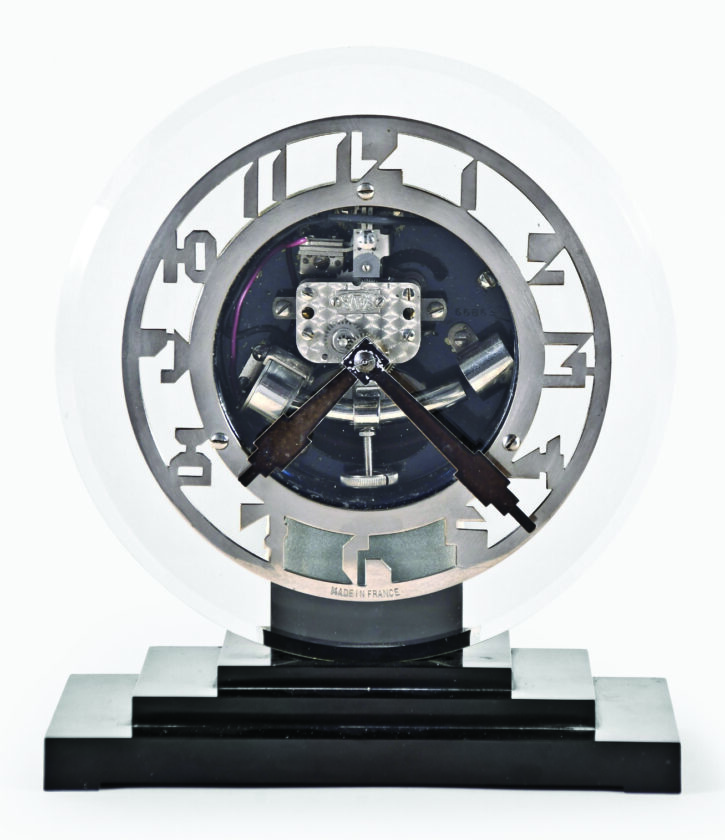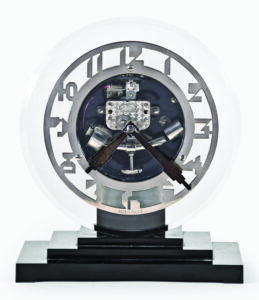Antique clocks come in a variety of styles

The first Sunday in November is the time to turn your clocks back an hour. This year, you might want to look back a century, too. The International Exhibition of Modern Decorative and Industrial Arts in Paris ended in November 1925, making art deco, the style it exhibited (not to mention named), officially antique at 100 years old. Its appeal is still going strong; dealers, decorators, and trend watchers have noticed a surge of interest in art deco in recent years.
The hundredth anniversary of the exhibition may be a factor, or maybe it’s just that the sleek lines and geometric shapes of art deco are truly timeless. This ATO electric clock sold for $1,020 at Schmitt Horan & Co. Dated to about 1930, its antique status may be debatable, but it is an exceptional piece of art deco-style. The stepped Bakelite base, echoed in the shape of the hands, combines characteristic shapes and materials of the era. The stylized chrome numerals still look modern.
The clock was designed by French horologist Leon Hatot (1883-1953), who established the ATO trademark in 1920. Known for his clocks and watches, which often overlap with jewelry and sculpture, Hatot is one of the quintessential French art deco designers. His electric clocks earned him the Grand Prix at the 1925 exhibition.
——
Q: I bought a bentwood high chair at a tag sale in the late 1970s. I had the caning redone and have used it to set stuffed animals on it. I recently began to think about what it might be worth, as I am interested in selling it. In researching it, I found that it looks like the Thonet high chairs. Can you tell me anything about it and what it might be worth?
A: Michael Thonet (1796-1871) patented multiple woodworking methods by 1841 and started a furniture business with his sons in 1849. He is best known for his bentwood furniture made of specially prepared beech wood, which was mass-produced and sold inexpensively. The furniture could be shipped in parts and assembled by shopkeepers.
Thonet furniture became extremely popular by the early 1900s. Many other companies made Thonet designs, and others copied them to make similar pieces. Check under the seat of your chair for a mark. Thonet chairs usually have the name “Thonet” impressed or stenciled on the back edge.
Antique and vintage Thonet bentwood chairs with caned seats can sell for anywhere from about $20 to over $100. Their age, the type of wood (for example, beech or oak), and the amount of detail in the design will contribute to the price. The Thonet company is still making furniture. They also have resources for authenticating vintage Thonet furniture. If you contact them online (thonet.de/en), they may be able to help you.
——
Q: I have an interesting old picture I bought along with some antique prints. It shows an indoor scene with a woman holding a baby in a room that looks like a parlor. It looks like a black and white photograph, but some parts are in color. It does not include a title or any information about the artist.
Was it hand-colored? Can you tell me anything about it? How can I find out about the photographer?
A: Hand-tinted photographs were popular in the early 20th century. Many photographers made them, and many have been reprinted since then. The book “Early Twentieth Century Hand-Painted Photography: Identification and Values” by Michael and Susan Ivankovich (Collector Books, 2005) is a good comprehensive guide to these photographers. The Wallace Nutting Collectors Club (wallacenutting.org) focuses on one of the most famous of these photographers (also known for his reproductions of the Colonial furniture that appeared in his photographs) but may have information on other creators of hand-colored photographs.
Even if you can’t confirm a photographer for your picture, you might be able to narrow down a date. The woman’s clothing and hairstyle may provide clues, as does the furniture and decorations in the room, especially if any technology, like a telephone or phonograph, is visible.
——
TIP: If your electric clock stops, turn it upside down for a day. The oil inside may flow into the gears, and the clock may start working again.

